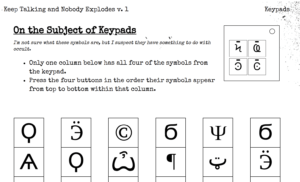For this competitive analysis, I wanted to explore another game that gives each player only half the information, and makes communicating what to do the challenge (both core parts of our game). In light of that, I chose to play “Keep Talking and Nobody Explodes” (KTNE). Here, one player is at a computer, and can see and manipulate the bomb. The other players are at a manual with instructions, and have to learn what the bomb looks like from their teammate, figure our what needs to be done, and then help their teammate do it before time runs out.

Here, there’s a few types of fun, but the one I’m particularly interested in is the challenge, since that’s what we’re having trouble figuring out in our playtests (although it also has a strong aspect of fellowship, as does our game!).
In KTNE, the challenge came at a couple of different levels. Actually manipulating the bomb itself was difficult for the defuser – you had to rotate it, read off a lot of different readings, and very quickly execute whatever the experts needed you to do. On top of that, you had to quickly communicate, decode as the expert, and juggle a wide range of tasks amongst yourselves.
Even though there were no explicit limits on what you could communicate, the fact that you had to manage either navigating the bomb or the manual while talking meant that communicating was still very hard. Figuring out efficient ways to convey instructions, and getting a good ‘workflow’ going where one expert at a time was talking while the other two researched, was quite fun. It elevated the pretty basic decoding tasks in the manual and made them genuinely engaging.

The points where this broke down were also illuminating. In particular, we found that one friend who was unfamiliar with videogames had a rough time as the defuser – the extra difficulty of using the controls made it a lot harder for her to keep talking and processing everything. Although the game itself isn’t particularly onerous, the context around it made the controls a lot less approachable, and added a lot of friction to the entire game.
We didn’t get a chance to try it, but it’s possible that the mobile version of this solves this problem, by using touch controls people are more broadly familiar with.
On a more general level, my main lesson from this is to make sure that the challenge is coming from the mechanics/dynamics you intend, and that, if it isn’t, it’s still fun! In the case of hidden information, and two-way communication, it seems like it’s important to make sure that there’s a balance between the mental load it takes to communicate, and to complete whatever other tasks are in the game. In our game, we’re trying to place a lot more of the challenge in communicating. Given we’re making that choice, we have to make sure that that process is interesting and fun. I’m not sure if we’re there at the moment, but KTNE gives a possible solution: open up the explicit restrictions on communication somewhat, and add other mechanics to make it challenging.



